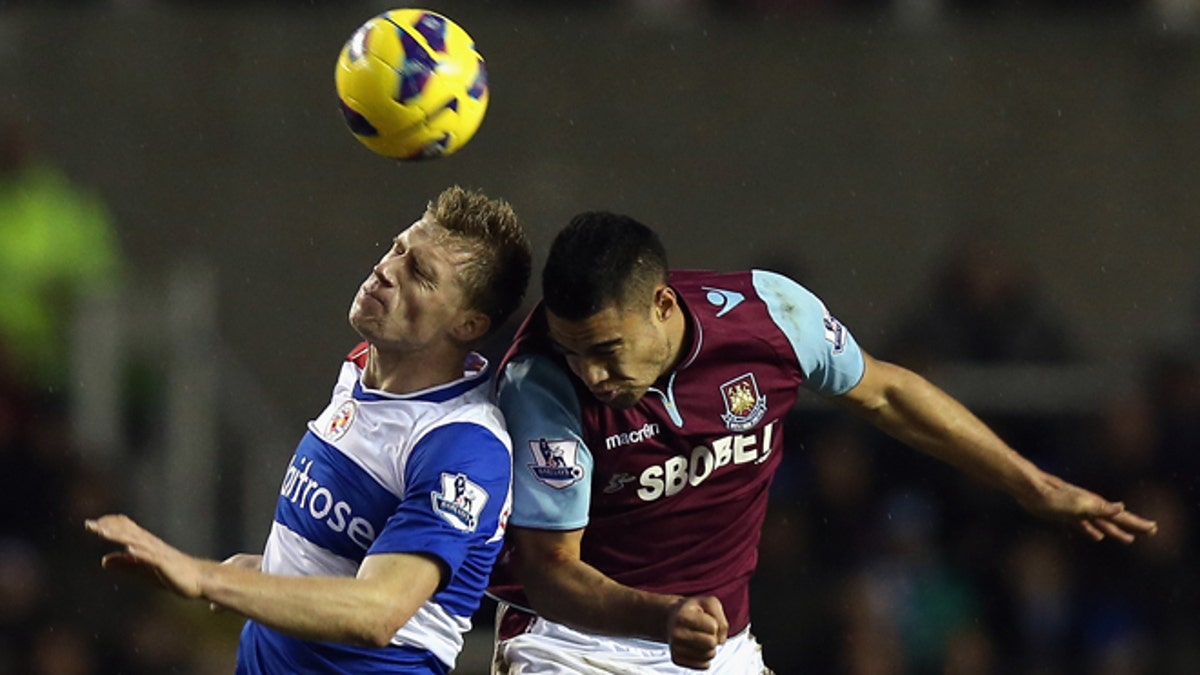
READING, ENGLAND - DECEMBER 29: Winston Reid of West Ham United clashes off Pavel Pogrebnyak of Reading during the Barclays Premier League match between Reading and West Ham United at the Madejski Stadium on December 29, 2012 in Reading, England. (Photo by Bryn Lennon/Getty Images) (2012 Getty Images)
Late last week U.S. Soccer released a new protocol attempting to curb concussion injuries in the youth game. One of the measures included banning heading the ball for players 10 and under, while banning it in practice for all soccer players up to 13.
The new steps were the response to a lawsuit filed against the organization over concussions in youth soccer, and they were welcomed by lawyers in the suit as well as by others in the game, including former U.S. men’s national team player and soccer analyst Taylor Twellman.
Twellman’s career ended early due to a concussion injury, and he has since dedicated himself to generating awareness about the dangers of head injuries in soccer.
Twellman told Fox News Latino, “This conversation has been happening behind closed doors for the last couple of years, and it’s wonderful to see it come out in public. This conversation will only continue to evolve.”
While applauding the step taken by U.S. Soccer, one can only wonder: If it weren’t for the lawsuit, would they have implemented anything?
FIFA, which was included in the lawsuit, seemed pleased that they were exonerated in terms of the lawsuit without even having to address the problem. FIFA declined to comment for this column.
However, even with this flurry of change, no one really is saying how we can best keep young soccer players safe.
Fox News Latino spoke with one of the country’s foremost experts on brain injuries, Dr. Robert C. Cantu, clinical professor in the department of neurosurgery at the Boston University School of Medicine and co-director of its brain trauma center. Cantu also advises the NFL on brain injuries.
“There is one particular act in playing soccer that leads to most concussions and that is the act of heading the ball,” Cantu said, “and it isn’t hitting the ball with your head, it’s [heads] and other body parts colliding.”
The problem is not purely as simple as eliminating heading.
“It is true that soccer has [developed] more physical contact through the years,” Cantu said. “I do think kids are getting bigger, stronger, faster and kids in general are getting rougher. And there is no question we are recognizing concussions better.”
The danger posed specifically to youth players is the most scrutinized for good reason. “The young developing brain is particularly susceptible to injury, on a number of fronts and unfortunately if you injure it, you may not reach the genetic potential you otherwise would have,” explained Cantu.
What makes it difficult is that symptoms are not always easy to spot.
Dr. Cantu said, “We are more and more understanding that there are two issues, one is concussion, and the other is just high numbers of repetitive sub-concussive blows that in and of themselves don’t cause symptoms but can cause structural brain damage.”
Few youth coaches have the proper training or history to detect these injuries, Cantu said. “It can be very difficult to recognize initially, and sometimes the trauma doesn’t seem to be that much. A better educational effort toward coaches would be ideal.”
U.S. Soccer is making concussion awareness information available for youth coaches, but it takes a long time to filter into the system considering the staggering amount of youth clubs in the United States.
Soccer players wear less protective gear than players in almost any other team sport, generally just pads that cover their shins.
The growing awareness of injuries has led to some new head gear that probably isn’t as effective as it seems.
Cantu said, “The head gear doesn’t do anything in terms of concussion. It helps in terms of getting a bruised or lacerated scalp. Prevention is a matter of reducing the trauma and preventing repeated trauma.”
Concussions in sports are nothing new. The unfortunate truth is that it takes a lawsuit to bring about real change. The issue of concussions has not changed the popularity of the NFL or the competitiveness of the athletes, but the awareness has certainly begun the discussion.
For the safety of our young soccer players, we should all get more informed and fast.
“Change comes hard,” Cantu concluded, “but I think change is coming.”
Video of the week
Wrong football, but still worthwhile. If you have a kid in sports, go see “Concussion.” It’s not a game.
From the wires
FIFA presidential candidate Prince Ali bin al-Hussein wants football leaders to help him find ideas to fight extremism and terrorism.
Prince Ali asks FIFA member federations "to join me in starting a serious dialogue within our football family to achieve that goal."
The Jordan federation president writes they can lead by "engaging our youth through football and sports" where "healthy competition and lifestyle can give them hope for a better future."
Prince Ali praises fans "who defy the terrorists with their love of the game and life."
Deadly attacks in Paris last Friday included suicide bombings outside the stadium as France played Germany.
Prince Ali says he lost friends 10 years ago when suicide bombers struck three hotels in Amman.
He is among five candidates in the Feb. 26 election.
The Associated Press contributed to this report.
